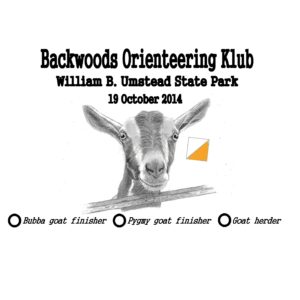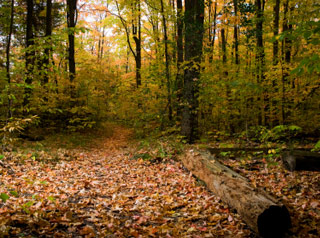BOK’s 2014 Bubbagoat race is now in the books. Look here for results.
A ‘goat’ race is a long and sometimes grueling orienteering course with several unusual rules that make the event especially fun. Listed here are some general features of goat races, followed by specific information about our event on the 19th. You can find more information about goat races here.
1. Mass start. Unlike most orienteering events, everyone participating in both the Bubba and the Pygmy goat will start in the same place, at the same time — promptly at 10:00 AM. The winner will thus be the person who finishes first. It is therefore important to be on time to the start, because if you get a late start, your place will still be based on the mass start time — not the time that you take off.
2. Following. Unlike all other orienteering situations, following other competitors is explicitly permitted. Of course, if you choose to follow another competitor there are risks involved: the person may not be on your course; the person may skip a control that you weren’t expecting (see below about skips); the person may get you lost. Even if you are following another runner, it is therefore very important to keep track of where you are on the map.
3. Skipped controls. Each competitor is allowed to skip at least one control. Rules about which controls can be skipped will be given at the briefing session 15 minutes before the race. Note that skipping a control will make your course somewhat shorter than the advertised distance for the entire course.
4. Forked controls. There may be one or more sets of forked controls on both the Bubba and the Pygmy goat courses. A forked control is one in which a competitor can choose which of two routes to take. As an example, let’s say that you get to control #6 and there is a fork going to two different #7 controls. On your map, lines to both #7’s would be shown, and the controls would be called ‘7A’ and ‘7B’. You would be able to decide which #7 you wanted to do — you should not go to both. It is possible for more than one control to be involved in a fork. Thus, to continue the example, 7A may lead to 8A and 7B may lead to 8B before joining back up at #9. Once you choose a direction on a fork, you will need to stick with it (e.g., do NOT do 7A and 8B). Eventually, both forking choices will rejoin back into a single course.
5. Length and difficulty. Traditionally, a goat race has the length of a long (blue) course — 10 – 15 km. However, the difficulty level is typically not fully advanced. Intermediate (orange) level controls are quite normal. Befitting the idea of a ‘goat’ race, courses are generally designed to have as much climb as the terrain realistically allows.
BOK’s 2014 Bubba Goat
1. Preregistration and Shirts. Shirts will be available (for $15) for all competitors of the Bubba and Pygmy goat (and for volunteers) who preregister before 5:00 PM on Thursday, October 9 (people who do the white and yellow courses will not receive a t-shirt). Note that this is a firm deadline that we need to enforce strictly in order to place our t-shirt order with the printer. People who register online after October 9 but before 5:00 PM on Friday, October 17 will be able to compete, but will not be guaranteed a t-shirt People who register online after 17 October or who register in person at the event may be able to participate in the goat races, but cannot be guaranteed a map. Day-of registration for white and yellow courses is completely fine, although groups of 5 or more are asked to pre-register. The table below specifies fees for members and non-members.
| BOK club member | Non-member | |
| Registration + T-shirt | $15 | $20 |
| Registration only | $0 | $5 |
Note that finger stick rental is available for people who do not have their own SI card. The rental fee will be $5, on top of the fees in the table above. Volunteers for the event who would like a “Goat herder” t-shirt should also register before the deadline, writing a brief note to the organizer that you will not be running and would prefer to help out. Volunteers will be especially appreciated to help with registration and control pickup.
Below is the preliminary design for the shirt, which will be printed on 100% cotton.
.
— Scroll down to register for this event —
2. Schedule. Competitors for the Bubba and Pygmy goat races should plan on being at Umstead north, shelter #1 and ready to run by 9:45 AM. At 9:45, the event director will review the rules and will provide important information about the race. Do not miss this briefing session. Maps will be distributed just before the briefing, and competitors will not be allowed to look at them until approximately one minute before the start. Maps will be pre-bagged and sealed. For those who want them, loose control sheets will be available before the briefing, although control descriptions will also be provided on the map. White and yellow courses will be open between 10:30 AM and 1 PM, although registration may be slowed around 12:15, when we hope to have a brief awards ceremony for the goat races. All competitors must be off their course by 2:00, when control pickup will begin.
3. Tentative course lengths (not including skips): Bubba Goat = 12.0 km (with 425 m of climb); Pygmy Goat = 5.6 km (with 175 m of climb). In addition to being significantly longer, the Bubba Goat will also be somewhat more technically challenging than the Pygmy. Competitors who have never run an advanced course (i.e., brown, green, red, or blue) are advised to register for the Pygmy goat. It will be permissible to switch from the Bubba to the Pygmy goat (but not vice versa) after the start, and instructions about how to do this will be given during the debriefing.
4. Camping/Lodging: If you’re coming from out of town and plan on staying in Raleigh/Durham for the weekend of BOK orienteering opportunities, camping is available at Umstead park. Click here for more information. Alternatively, Choice Hotels has a number of properties in the RDU airport and Raleigh (e.g. Crabtree Valley) area that are also fairly close to our event locations. Choice Hotels is a sponsor of Orienteering USA, and discounts at these hotels are available for OUSA members. Click here for details.
5. Course setter notes.
Map and venue information: Maps for the goat courses will be printed at a scale of 1:10,000. (White and Yellow maps will probably be printed at 1:7500.) Bubba-goat maps will be printed on 11″ x 17″ pages, and Pygmy-goat maps will be printed on 8.5″ x 11″ pages. All Bubba and Pygmy maps will be pre-sealed in plastic bags. Control descriptions will be printed on the map, and will be available before the race on loose sheets. Overprint color will be bright scarlet. (Please let the event director know if you’re color blind, and we could switch to magenta.) The Bubba-goat map will show a magenta line that indicates how to switch from the Bubba to the Pygmy course. (Making this switch will involve running a small extra distance as a penalty.)
The woods at Umstead are generally quite runnable, and unlike many other orienteering maps, the runnability of the woods is probably underestimated on the Umstead map. In other words, areas that are shaded in light or medium green are generally pretty runnable, and don’t need to discourage people from going through them. There are a large number of rock piles in Umstead, mapped as cairns; however, not every single rock pile is mapped. Don’t fret unnecessarily if you find a rock pile that is not on the map. BOK members will be very familiar with the non-IOF ‘downed tree’ symbol, which is represented by a green X, with a long trailing leg that indicates the direction of the downed tree trunk. These symbols were incorporated onto the map shortly after the 1996 hurricane, Fran. Since that time, many of these tree trunks have decayed significantly, and are not always the most prominently mappable objects in the woods. Competitors should thus not rely too heavily on the mapped trees, and may regard them best as suggestive of the downed vegetation in the area.
Course information: The Bubba-goat will have 27 controls and the Pygmy will have 14. Expect to find two control flags and SI boxes at your first control. You may punch either one — you don’t need to punch both. The two units are only there to reduce possible congestion at the first control. There will be one manned control about halfway through the Bubba-goat that has water available. In addition, two legs on the Bubba-goat, and one leg on the Pygmy-goat, will pass very close to working park water fountains. Thus, unless it is unusually hot, competitors will probably not need to carry their own water; however, those who want to control when and how much water they drink are encouraged to carry their own.
Questions? Contact David Waller at dw.orienteer@gmail.com
